
An abbey is a type of monastery used by members of a religious order under the governance of an abbot or abbess. Abbeys provide a complex of buildings and land for religious activities, work, and housing of Christian monks and nuns.
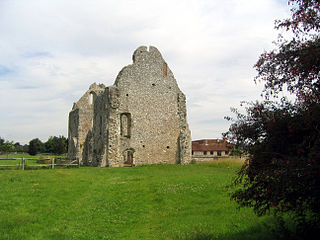
Boxgrove Priory is a ruined priory in the village of Boxgrove in Sussex, England. It was founded in the 12th century.

Jervaulx Abbey in East Witton in North Yorkshire, 14 mi (23 km) north-west of the city of Ripon, was one of the great Cistercian abbeys of Yorkshire, England, dedicated to St Mary in 1156. It is a Grade I listed building.

Richmond is a market town and civil parish in North Yorkshire, England. It is located at the point where Swaledale, the upper valley of the River Swale, opens into the Vale of Mowbray. The town's population at the 2011 census was 8,413. The town is 13 miles (21 km) north-west of Northallerton, the county town, and 41 miles (66 km) north-west of York.

Bolton-on-Swale is a village and civil parish in the Richmondshire district of North Yorkshire, England. In 2015, North Yorkshire County Council estimated the population of the civil parish to be 70.

Brompton-on-Swale is a village and civil parish in the Richmondshire district of North Yorkshire, England. The village is located three miles east of Richmond and 10 miles (16 km) north-west of the county town of Northallerton on the northern bank of the River Swale.

Skeeby is a village and civil parish about 18 miles (29 km) north-west of the county town of Northallerton in North Yorkshire, England.

Downholme is a village and civil parish in North Yorkshire, England. It is situated approximately 4 miles (6 km) west from the market town of Richmond and 16 miles (26 km) west from the county town of Northallerton. The village lies close to the edge of the Yorkshire Dales. The population as taken in the ONS Census of 2011 was less than 100, so details are included in the parish of Hudswell. In 2015, North Yorkshire County Council estimated the population of the village to be 50.

Easby is a hamlet and civil parish in the Richmondshire district of North Yorkshire, England. It is situated near Richmond on the banks of the River Swale, approximately 12 miles (19 km) north west from the county town of Northallerton. The population taken by ONS was less than 100. Population information is included in the parish of Hudswell.
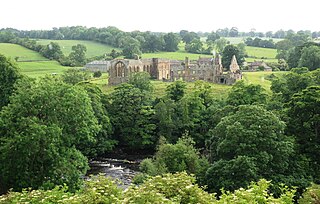
Egglestone Abbey is a ruined Premonstratensian abbey in County Durham, England. It is located 1+1⁄2 miles (2.4 km) south-east of Barnard Castle, on the south bank of the River Tees, and was historically within the North Riding of Yorkshire.

Coverham Abbey, North Yorkshire, England, was a Premonstratensian monastery that was founded at Swainby in 1190 by Helewisia, daughter of the Chief Justiciar Ranulf de Glanville. It was refounded at Coverham in about 1212 by her son Ranulf fitzRalph, who had the body of his late mother reinterred in the chapter house at Coverham.

Coverdale is a dale in the far east of the Yorkshire Dales, North Yorkshire, England. It takes its name from the River Cover, a tributary of the River Ure. The dale runs south-west from the eastern end of Wensleydale to the dale head at a pass, known as Park Rash Pass, between Great Whernside to the south and Buckden Pike to the north. It is accessible by a single track road, which runs the length of the dale and over the pass to Kettlewell in Wharfedale. The name is taken from that of the River Cover, which is of Brittonic origin. Ekwall suggested that it might mean "hollow stream", but more recently Andrew Breeze has argued that it is cognate with Welsh gofer "streamlet".
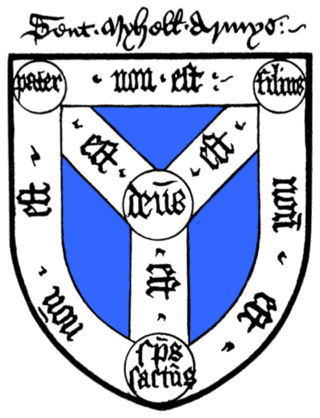
The Holy Trinity Priory, also known as Christchurch Aldgate, was a priory of Austin canons founded around 1108 by the English queen Matilda of Scotland near Aldgate in London.
Sir Henry le Scrope was an English lawyer, and Chief Justice of the King's Bench for two periods between 1317 and 1330. He was the eldest son of Sir William le Scrope, who was bailiff to the earl of Richmond in Richmondshire. Henry's younger brother Geoffrey was also a lawyer who probably advanced through the influence of his older brother. Geoffrey served as Chief Justice four times between 1324 and 1338.
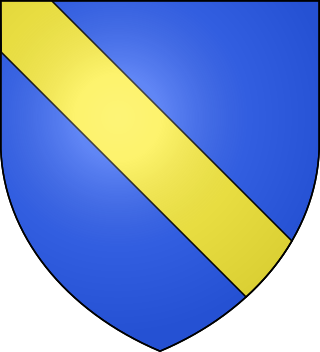
Richard le Scrope, 1st Baron Scrope of Bolton was an English soldier and courtier, serving Richard II of England. He also fought under the Black Prince at the Battle of Crecy in 1346.
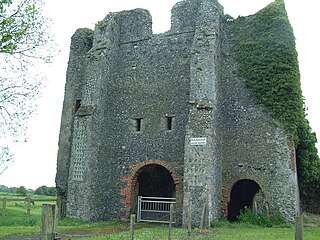
St. Radegund's Abbey at Bradsole was a medieval monastic house in the parish of Hougham Without near Dover in southeast England. It was dedicated to Radegund, the sixth-century Merovingian princess, who, once married to the unsavory King Chlothar I, turned to a life of asceticism and charitable works. The remains of the abbey buildings have since have been incorporated into a farm.

Newsham Abbey was an abbey in Newsham, a small hamlet north of Brocklesby village in Lincolnshire, England, and one of nine within the historical county. Founded by Peter of Gousla in 1143, Newsham was a daughter house of the Abbey of Licques, near Calais, and the first Premonstratensian house established in England.

The Church of St Mary the Virgin, Richmond, is the Anglican parish church in the town of Richmond in North Yorkshire, England. Previously, there was another church, the Church of the Holy Trinity, which served as a chapel, and in the early part of the twentieth century, it was officiated over by the incumbent of St Mary's. In the 1960s, Holy Trinity was deconsecrated and now serves as the Green Howards' museum in the town.


























